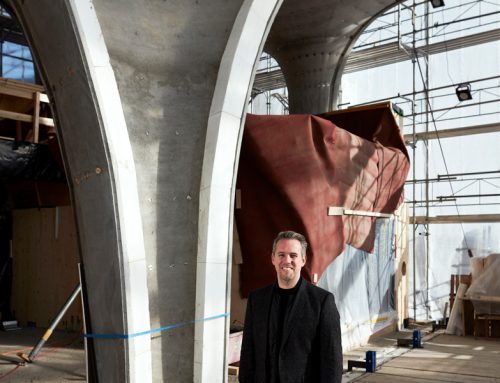If you are worried about South Africa’s economy and whether there are still opportunities here, speak to GG Alcock and your optimism will be restored.
There are lucrative markets staring at South African producers and businesses, but they are simply not seeing them. That’s what GG Alcock says. The CEO of Minanawe, a specialist marketing company that focuses on the informal market and informal economy, he has worked in this sector for twenty years; this is where he feels at home.
Before exploring his insights, a bit of background on GG is required as he is a fascinating mix of South African cultures, having grown up as a traditional Zulu boy, alongside his brother Khonya, in rural KwaZulu-Natal.
His parents, Neil and Creina Alcock, were humanitarians who gave up comfortable lives to move to the Msinga Valley. They lived and worked amongst the Mchunu and Mthembu people, fighting for the rights of those displaced by the apartheid government’s forced removals.
The Alcock family lived in a mud hut with no electricity and GG and Khonya were home-schooled by their mother under an acacia tree until high school when the Department of Education forced them to go to a ‘real school’. Neil was murdered when GG was 14; Creina still lives in the Msinga Valley.
In his early twenties, GG worked for a number of anti-apartheid organisations on legal challenges to the Land Act before eventually moving to Joburg where he now lives with is wife and daughters.
He still thinks in Zulu and has since authored two books. The first, ‘Third World Child – Born White, Zulu Bred’ explores his life from childhood to adulthood and how he eventually moved to Joburg and pursued his marketing career with a difference. His second book, ‘KasiNomics – African informal economies and the people who inhabit them’, was published in November 2015.
The name of the book comes from eKasi and lokasie, the South African townships, with their thriving informal economies and energetic entrepreneurs, which GG believes is what keeps the South African economy strong, despite the bashing the formal economy is taking.
“There are huge opportunities out there in the informal economy and export market, yet producers and business people in the formal economy aren’t seeing them,” says GG who urges farmers and agri businesses to explore and pursue the direct marketing opportunities they present.
To illustrate this he says he shows people a photograph of a tractor in a farmland and then he shows them a photograph of a woman with a herd of goats. He asks them which is the commercial farmer, and they invariably point to the photo of the tractor in a farmland.
“This highlights the need for South African producers to start think non-traditionally because the goat industry is potentially worth R3 billion a year, and that is just in South Africa,” he explains.
“The woman with her herd of goats is every bit a commercial farmer if you consider that thousands of goats get sold on the outskirts of every large or sizeable township in the country every week for all the traditional ceremonies that people uphold, and this includes people who have ‘modernised’.
“No matter how much people modernise, or where they live or what kind of glittering lifestyle they lead, they retain certain strong cultural practices. This applies to all cultures,” he says.
In the townships, it is therefore not at all out of place to have people in suits and luxury vehicles arriving to buy goats and cattle at the township markets for traditional ceremonies.
“Customers arrive at the livestock markets in every conceivable type of transport – from wheelbarrows to Pajeros – to buy the goats and cows. They also come to buy fresh meat from the local meat merchants; they don’t want the rump and sirloin, they buy the front part of the cow, the chuck and blade,” he explains.
“A woman I interviewed at a livestock market on the outskirts of Soweto who was driving a Mercedes and wearing imported high heels told me that she owns a driving school and at the same time she is a traditional healer or sangoma. She simply changes into her sangoma outfit when she is consulting.”
Ceremonies where an animal must be slaughtered, including celebrations and funerals, are massive in the townships, he explains.
“Many African people believe that if you take care of the past the future will take care of itself, so you have to ensure that people get a proper burial. A year later there is another ceremony to welcome their spirit home. Both ceremonies require a ritual slaughter, and it costs a lot of money, which is why so many people belong to burial societies. With modernisation, people often don’t want to do the killing themselves, and people have created careers out of hiring themselves out to do this.
“It’s huge business and South African farmers are not taking advantage of these markets. That is why we are importing 300 000 goats a year from SADC countries, at a cost of about R500 million,” he explains.
“South Africa is also not taking advantage of the export market,” he adds. “The Somali goat market sells three millions of goats a year to Saudi Arabia, with thousands of farmers, like the woman with her herd of goats, contributing to the market. The goats are then transported in converted oil tankers to Saudi.”
“The question is why isn’t South Africa supplying markets where the demand is vast. Saudi Arabia approached the KwaZulu-Natal government to supply a million goats a year, which could have been an incredible agricultural job-creation initiative but they did not supply a single one.”
GG believes that most people are so conditioned into thinking that governments or large corporations need to lead these initiatives that they are not looking at what is happening on the ground. In Africa it is all about a whole lot of small-scale producers, small-scale businesses and small-scale entrepreneurs coming together to make a big impact.
“’We don’t have the entrepreneurs’ is the standard response,” says GG. “The Minister of Small Business Development, Lindiwe Zulu, keeps talking about developing entrepreneurs when millions of entrepreneurs are operating in every single informal community.”
Suggestions that they are not organised or business-minded are left in the dust when you spend time in the townships.
“Take the women who hawk vegetables at the large taxi ranks such as Baragwanath in Soweto or Khayelitsha in Cape Town or Dalton Road in Durban,” GG explains. “These women are highly organised into groups of, for example, 20 women, who will all be up at 4am three times a week to catch the taxi to the fresh produce market, with each of them carrying about R1500 to spend, or R30 000 for the group. And there are thousands of similar groups doing this.”
They bid for their produce alongside all the big supermarket buyers, and by 5.30am they are done. Then they hire a bakkie to transport their produce back to their taxi rank. One of the women accompanies the bakkie driver and the rest catch a taxi back to their home taxi rank where divide the produce between all the sellers and get to work.
They all have regular customers who say they prefer to buy from the women because they get fresh produce at a good price directly from the market, and because they know the women, they are part of their community.
“There is a strong ‘locavore’ factor in the informal sector, where people buy local, and it is a growing trend across all sectors of our society,” says GG.
“When people buy local, they have a bit of a chat and there is a warm, personalised relationship, which is what people need and which large retailers and companies lack. These women, small as their groups are, are real competition for the supermarkets.”
GG’s challenge to producers is to get to know the informal market and to potentially directly supply the buyers, such as these groups of women.
“People have no idea how much cash is changing hands in the informal economy. If you look at the medicinal plant or muthi market, for example, it is worth R3 billion a year, it employs approximately 133 000 people and medicinal plants are used by approximately 27 million consumers in South Africa alone.
“If you look at the dagga trade, it is unbelievably lucrative. A sack of dagga that costs R5000 on the bank of the Tugela will be sold on the streets of Joburg for R400 000.”
Then there is the massive ‘kota’ industry in South Africa, which is worth about R10 billion a year. “The ‘kota’ is a quarter of a loaf of bread, stuffed with slap chips, polony, fried egg, atchar, tomato sauce and a cheese slice,” he explains. “It is the most delicious thing in the world but probably the worst thing from a health perspective.”
In South Africa, an estimated 50 000 kota outlets are being run by township entrepreneurs in street stalls, kiosks and caravans. At R12 to R17 each it’s a very lucrative fast food trade.
“One guy in Alex employs 30 staff to supply his kota outlets,” GG explains. This Kota entrepreneur works seven days a week and turns over R35 000 to R50 000 a day. After costs, about 10% goes into his back pocket. Another outlet in Soweto sells 2400 kotas a day and his staff peel 80 large bags of potatoes a day as part of the preparation.”
Then there are the estimated 500 000 hawkers in South Africa who sell everything from vetkoek to sweets and vegetables, and, on average, each hawker earns R3000 a month.
“They might not all be paying tax on their earnings but they are all paying Vat and they are all working,” says GG. “The formal sector statistics put unemployment at about 30% but no one is measuring all the jobs in the informal sector. Neither is the formal economy accommodating the many successful informal sector entrepreneurs, who operate in cash and are therefore battle to purchase cars or houses because the system does not recognise them.”
Six years ago GG helped Parmalat to get their cheese slices into the kota market, and the cheese slice market has grown into a R1 billion a year market with Parmalat retaining about 85% of it:
“We directly approached the kota outlet owners and offered them free trial Parmalat cheese slices in their kotas, and free Parmalat-branded kota menu boards. It took off and kota entrepreneurs are now part of a brand loyalty club where they earn points towards items like kitchen utensils and fridges.
Kota kiosks and other ‘fast food’ kiosks, know their customers and their menus include a range of favourite dishes – from samp and beans to meat and rice to shisanyama to sishebo (African-style curry).
“People are often prepared to pay more for their plate from a fast food kiosk because it is cooked the way they like it and it is fresh,” says GG.
“It is all about being responsive to your specific market,” says GG for whom this approach has handsomely rewarded him. His company has just been bought buy a large French-based company called ‘Publicis’ who wants to grow its footprint in Africa where the informal market and kasinomics offer untold, unchartered opportunities. If they can see this, shouldn’t we?
To contact GG Alcock
Email: gg@minanawe.co.za
Cellphone: 082 900 7738
All proceeds from KasiNomics go to the Mdukatshani Rural Development Project in Msinga, KwaZulu-Natal www.mdukatshani.com
KasiNomics is published by Tracey McDonald Publishers www.traceymcdonaldpublishers.com




